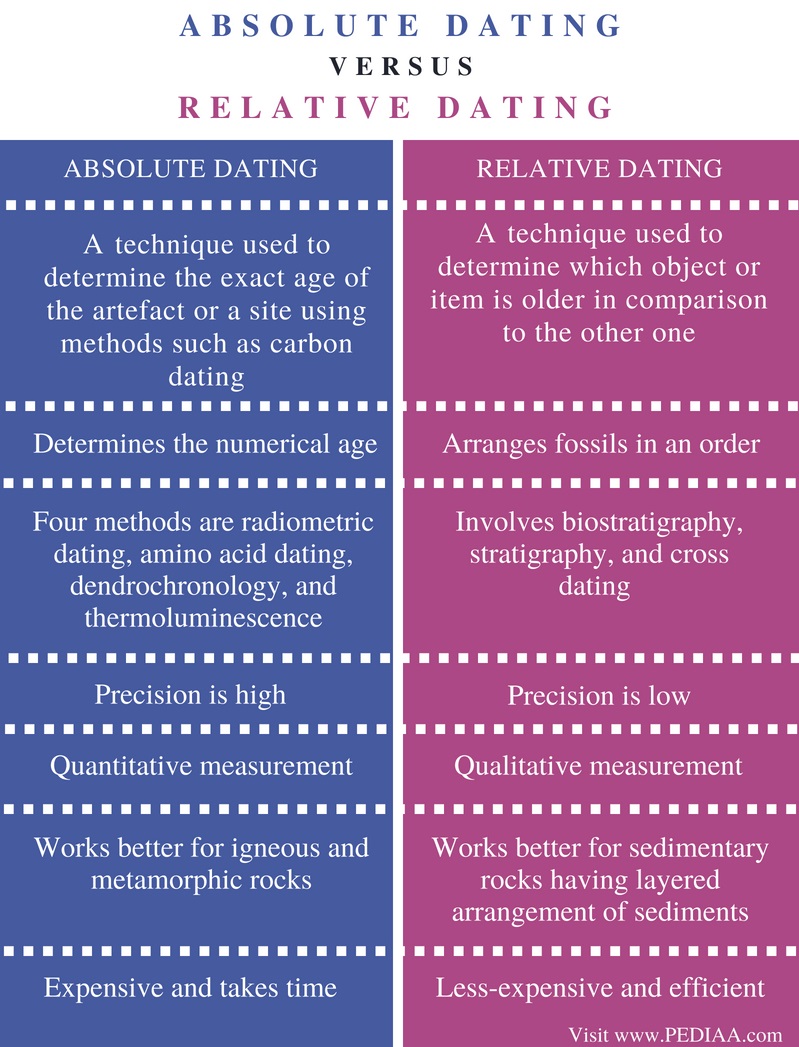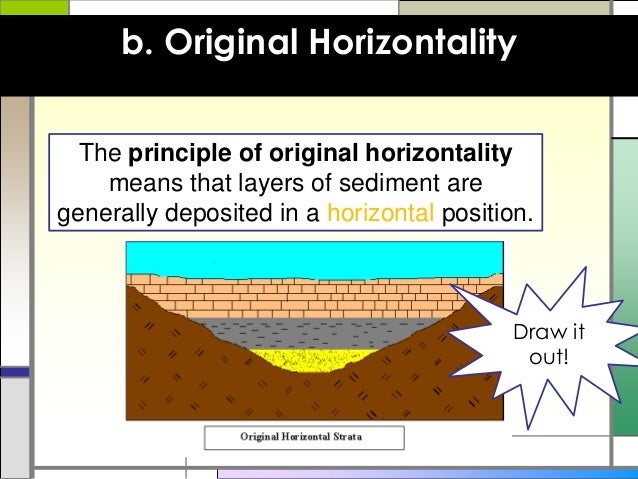- Radioactive dating
- MATERIALS REQUIRED FOR EACH GROUP
- Dating Fossils – How Are Fossils Dated? - media-aid.com
- Relative dating
- Get NoDafied
The isotopes are then measured within the same machine by an attached mass spectrometer an example of this is SIMS analysis. This is a common dating method mainly used by archaeologists, as it can only date geologically recent organic materials, usually charcoal, but also bone and antlers. All living organisms take up carbon from their environment including a small proportion of the radioactive isotope 14C formed from nitrogen as a result of cosmic ray bombardment. The amount of carbon isotopes within living organisms reaches an equilibrium value, on death no more is taken up, and the 14C present starts to decay at a known rate.
The amount of 14C present and the known rate of decay of 14C and the equilibrium value gives the length of time elapsed since the death of the organism. This method faces problems because the cosmic ray flux has changed over time, but a calibration factor is applied to take this into account. Radiocarbon dating is normally suitable for organic materials less than 50 years old because beyond that time the amount of 14C becomes too small to be accurately measured.
This scheme was developed in but became more useful when mass spectrometers were improved in the late s and early s. However, both Rb and Sr easily follow fluids that move through rocks or escape during some types of metamorphism. This technique is less used now. The dual decay of potassium K to 40Ar argon and 40Ca calcium was worked out between and This technique has become more widely used since the late s.
Radioactive dating
Its great advantage is that most rocks contain potassium, usually locked up in feldspars, clays and amphiboles. However, potassium is very mobile during metamorphism and alteration, and so this technique is not used much for old rocks, but is useful for rocks of the Mesozoic and Cenozoic Eras, particularly unaltered igneous rocks. This technique developed in the late s but came into vogue in the early s, through step-wise release of the isotopes. This technique uses the same minerals and rocks as for K-Ar dating but restricts measurements to the argon isotopic system which is not so affected by metamorphic and alteration events.
It is used for very old to very young rocks. The decay of Sm to Nd for dating rocks began in the mids and was widespread by the early s. It is useful for dating very old igneous and metamorphic rocks and also meteorites and other cosmic fragments. However, there is a limited range in Sm-Nd isotopes in many igneous rocks, although metamorphic rocks that contain the mineral garnet are useful as this mineral has a large range in Sm-Nd isotopes.
This technique also helps in determining the composition and evolution of the Earth's mantle and bodies in the universe. The Re-Os isotopic system was first developed in the early s, but recently has been improved for accurate age determinations. The main limitation is that it only works on certain igneous rocks as most rocks have insufficient Re and Os or lack evolution of the isotopes.

This technique is good for iron meteorites and the mineral molybdenite. This system is highly favoured for accurate dating of igneous and metamorphic rocks, through many different techniques.
MATERIALS REQUIRED FOR EACH GROUP
It was used by the beginning of the s, but took until the early s to produce accurate ages of rocks. The great advantage is that almost all igneous and metamorphic rocks contain sufficient U and Pb for this dating. It can be used on powdered whole rocks, mineral concentrates isotope dilution technique or single grains SHRIMP technique. It has revolutionised age dating using the U-Pb isotopic system. Using the SHRIMP, selected areas of growth on single grains of zircon, baddeleyite, sphene, rutile and monazite can be accurately dated to less than years in some cases. It can even date nonradioactive minerals when they contain inclusions of zircons and monazite, as in sapphire grains.
It can help fix the maximum age of sedimentary rocks when they contain enough accessory zircon grains usually need about grains. Because of advancements in geochronology for over 50 years, accurate formation ages are now known for many rock sequences on Earth and even in space.
The oldest accurately dated rocks on Earth are metamorphosed felsic volcanic rocks from north-west Western Australia. These were dated at about 4. Several minerals incorporate tiny amounts of uranium into their structure when they crystallise. The radioactive decay from the uranium releases energy and particles this strips away electrons leading to disorder in the mineral structure.
Dating Fossils – How Are Fossils Dated? - media-aid.com
The travel of these particles through the mineral leaves scars of damage about one thousandth of a millimetre in length. These 'fission tracks' are formed by the spontaneous fission of U and are only preserved within insulating materials where the free movement of electrons is restricted. Because the radioactive decay occurs at a known rate, the density of fission tracks for the amount of uranium within a mineral grain can be used to determine its age.
To see the fission tracks, the mineral surface is polished, etched with acids, and examined with an electron microscope. An effective way to measure the uranium concentration is to irradiate the sample in a nuclear reactor and produce comparative artificial tracks by the induced fission of U.
Fission track dating is commonly used on apatite, zircon and monazite. Methods for relative dating were developed when geology first emerged as a natural science in the 18th century. Geologists still use the following principles today as a means to provide information about geologic history and the timing of geologic events.
- free brazil dating.
- Dating Fossils – How Are Fossils Dated?.
- free dating site in columbia sc.
- How are relative dating and absolute dating alike - NoDa Brewing Company.
- How are relative dating and absolute dating alike;
The principle of Uniformitarianism states that the geologic processes observed in operation that modify the Earth's crust at present have worked in much the same way over geologic time. The principle of intrusive relationships concerns crosscutting intrusions. In geology, when an igneous intrusion cuts across a formation of sedimentary rock , it can be determined that the igneous intrusion is younger than the sedimentary rock.
There are a number of different types of intrusions, including stocks, laccoliths , batholiths , sills and dikes. The principle of cross-cutting relationships pertains to the formation of faults and the age of the sequences through which they cut.
Relative dating
Faults are younger than the rocks they cut; accordingly, if a fault is found that penetrates some formations but not those on top of it, then the formations that were cut are older than the fault, and the ones that are not cut must be younger than the fault. Finding the key bed in these situations may help determine whether the fault is a normal fault or a thrust fault. The principle of inclusions and components explains that, with sedimentary rocks, if inclusions or clasts are found in a formation, then the inclusions must be older than the formation that contains them.
For example, in sedimentary rocks, it is common for gravel from an older formation to be ripped up and included in a newer layer. A similar situation with igneous rocks occurs when xenoliths are found. These foreign bodies are picked up as magma or lava flows, and are incorporated, later to cool in the matrix. As a result, xenoliths are older than the rock which contains them. The principle of original horizontality states that the deposition of sediments occurs as essentially horizontal beds.
Observation of modern marine and non-marine sediments in a wide variety of environments supports this generalization although cross-bedding is inclined, the overall orientation of cross-bedded units is horizontal.
The law of superposition states that a sedimentary rock layer in a tectonically undisturbed sequence is younger than the one beneath it and older than the one above it. This is because it is not possible for a younger layer to slip beneath a layer previously deposited. This principle allows sedimentary layers to be viewed as a form of vertical time line, a partial or complete record of the time elapsed from deposition of the lowest layer to deposition of the highest bed.
The principle of faunal succession is based on the appearance of fossils in sedimentary rocks. As organisms exist at the same time period throughout the world, their presence or sometimes absence may be used to provide a relative age of the formations in which they are found.
Get NoDafied
Based on principles laid out by William Smith almost a hundred years before the publication of Charles Darwin 's theory of evolution , the principles of succession were developed independently of evolutionary thought. The principle becomes quite complex, however, given the uncertainties of fossilization, the localization of fossil types due to lateral changes in habitat facies change in sedimentary strata , and that not all fossils may be found globally at the same time.
The principle of lateral continuity states that layers of sediment initially extend laterally in all directions; in other words, they are laterally continuous. As a result, rocks that are otherwise similar, but are now separated by a valley or other erosional feature, can be assumed to be originally continuous.
Layers of sediment do not extend indefinitely; rather, the limits can be recognized and are controlled by the amount and type of sediment available and the size and shape of the sedimentary basin. Sediment will continue to be transported to an area and it will eventually be deposited. However, the layer of that material will become thinner as the amount of material lessens away from the source. Often, coarser-grained material can no longer be transported to an area because the transporting medium has insufficient energy to carry it to that location. In its place, the particles that settle from the transporting medium will be finer-grained, and there will be a lateral transition from coarser- to finer-grained material.
The lateral variation in sediment within a stratum is known as sedimentary facies.
